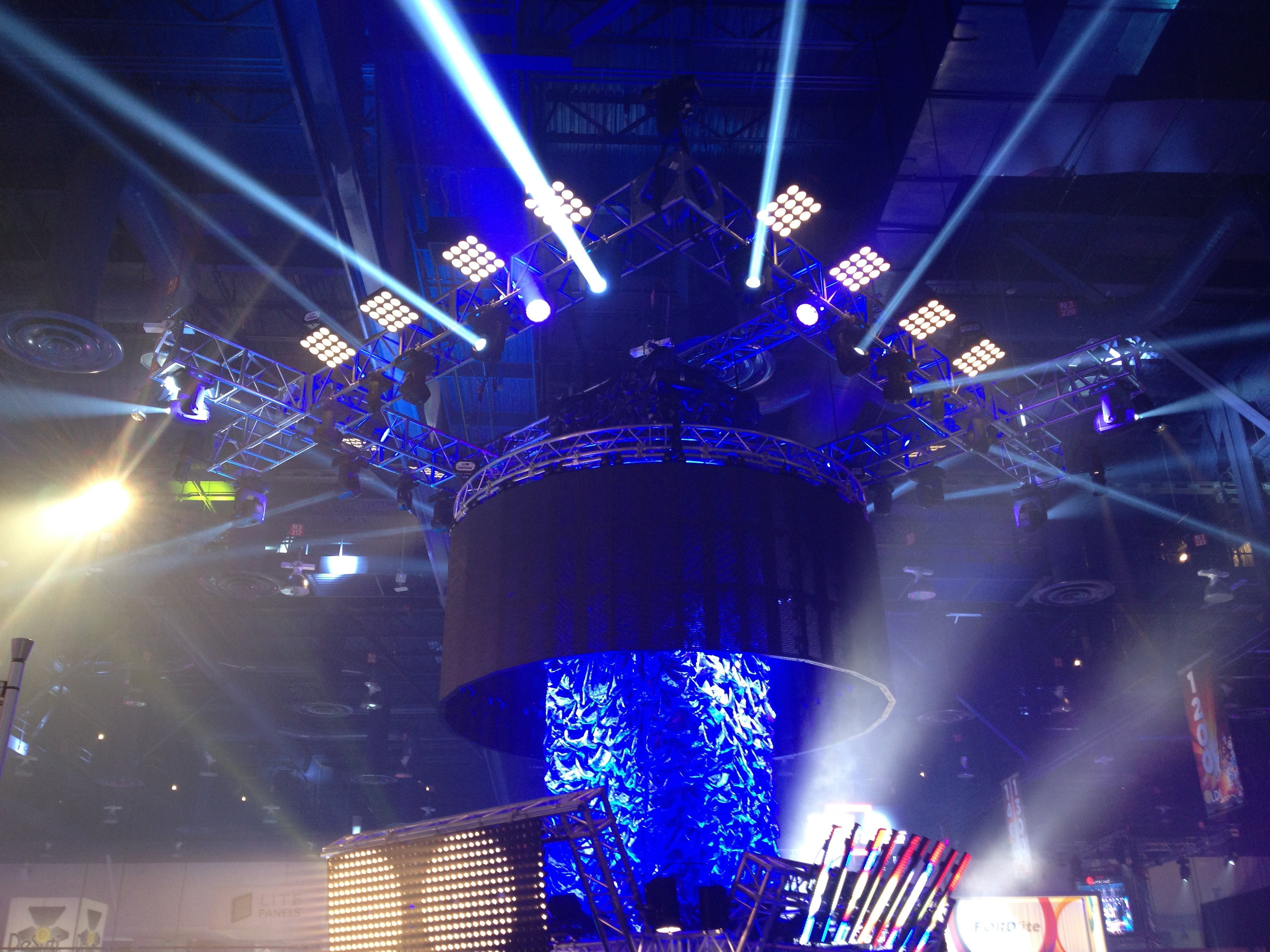Trade Fair on:
[Wikipedia]
[Google]
[Amazon]
 A trade fair, also known as trade show, trade exhibition, or trade exposition, is an exhibition organized so that companies in a specific industry can showcase and demonstrate their latest products and services, meet with industry partners and customers, study activities of rivals, and examine recent market trends and opportunities.
In contrast to consumer fairs, only some trade fairs are open to the public, while others can only be attended by company representatives (members of the trade, e.g. professionals) and members of the press, therefore trade shows are classified as either "public" or "trade only". A few fairs are hybrids of the two; one example is the Frankfurt Book Fair, which is trade only for its first three days and open to the general public on its final two days. They are held on a continuing basis in virtually all markets and normally attract companies from around the globe. For example, in the U.S., there are currently over 10,000 trade shows held every year, and several online directories have been established to help organizers, attendees, and marketers identify appropriate events.
A trade fair, also known as trade show, trade exhibition, or trade exposition, is an exhibition organized so that companies in a specific industry can showcase and demonstrate their latest products and services, meet with industry partners and customers, study activities of rivals, and examine recent market trends and opportunities.
In contrast to consumer fairs, only some trade fairs are open to the public, while others can only be attended by company representatives (members of the trade, e.g. professionals) and members of the press, therefore trade shows are classified as either "public" or "trade only". A few fairs are hybrids of the two; one example is the Frankfurt Book Fair, which is trade only for its first three days and open to the general public on its final two days. They are held on a continuing basis in virtually all markets and normally attract companies from around the globe. For example, in the U.S., there are currently over 10,000 trade shows held every year, and several online directories have been established to help organizers, attendees, and marketers identify appropriate events.

 Trade fairs play important roles in
Trade fairs play important roles in 
 A trade fair, also known as trade show, trade exhibition, or trade exposition, is an exhibition organized so that companies in a specific industry can showcase and demonstrate their latest products and services, meet with industry partners and customers, study activities of rivals, and examine recent market trends and opportunities.
In contrast to consumer fairs, only some trade fairs are open to the public, while others can only be attended by company representatives (members of the trade, e.g. professionals) and members of the press, therefore trade shows are classified as either "public" or "trade only". A few fairs are hybrids of the two; one example is the Frankfurt Book Fair, which is trade only for its first three days and open to the general public on its final two days. They are held on a continuing basis in virtually all markets and normally attract companies from around the globe. For example, in the U.S., there are currently over 10,000 trade shows held every year, and several online directories have been established to help organizers, attendees, and marketers identify appropriate events.
A trade fair, also known as trade show, trade exhibition, or trade exposition, is an exhibition organized so that companies in a specific industry can showcase and demonstrate their latest products and services, meet with industry partners and customers, study activities of rivals, and examine recent market trends and opportunities.
In contrast to consumer fairs, only some trade fairs are open to the public, while others can only be attended by company representatives (members of the trade, e.g. professionals) and members of the press, therefore trade shows are classified as either "public" or "trade only". A few fairs are hybrids of the two; one example is the Frankfurt Book Fair, which is trade only for its first three days and open to the general public on its final two days. They are held on a continuing basis in virtually all markets and normally attract companies from around the globe. For example, in the U.S., there are currently over 10,000 trade shows held every year, and several online directories have been established to help organizers, attendees, and marketers identify appropriate events.
History
Modern trade fairs follow in the tradition of trade fairs established in late medieval Europe such as the Champagne fairs or theSkåne Market
The Skåne Market or Scania market (Danish ''Skånemarkedet'', Swedish ''Skånemarknaden'') was a major fish market for herring which took place annually in Scania during the Middle Ages. From around 1200, it became one of the most important events ...
, in the era of merchant capitalism. In this era, produce and craft producers visited towns for trading fairs, to sell and showcase products. From the late eighteenth century, industrial exhibitions in Europe and North America became more common reflecting the technological dynamism of the Industrial Revolution
The Industrial Revolution was the transition to new manufacturing processes in Great Britain, continental Europe, and the United States, that occurred during the period from around 1760 to about 1820–1840. This transition included going f ...
.
In the late 19th century, the concept of annual industry-wide trade shows gained traction, spreading from European manufacturing centers to North America. By the 20th century, specialized companies came into existence simply to manage the trade-show industry, and permanent trade show grounds or convention centers were established as venues that featured a rotating calendar of trade shows.
In the 21st century, with the rapid industrialization of Asia
Asia (, ) is one of the world's most notable geographical regions, which is either considered a continent in its own right or a subcontinent of Eurasia, which shares the continental landmass of Afro-Eurasia with Africa. Asia covers an ...
, trade shows and exhibitions are now commonplace throughout the Asian continent, with China dominating the exhibitions industry in Asia, accounting for more than 55 per cent of all space sold in the region in 2011.
Use

 Trade fairs play important roles in
Trade fairs play important roles in marketing
Marketing is the process of exploring, creating, and delivering value to meet the needs of a target market in terms of goods and services; potentially including selection of a target audience; selection of certain attributes or themes to empha ...
as well as business networking in market sectors that use them. People will seek to meet people and companies at their own level in the supply chain
In commerce, a supply chain is a network of facilities that procure raw materials, transform them into intermediate goods and then final products to customers through a distribution system. It refers to the network of organizations, people, acti ...
, as well as potential suppliers and potential buyers.
Generally there will be a central trade show floor with booths where people exhibit their goods or services, and throughout the day there will be seminars for continuing education on matters relevant to the industry, like best practices, trends, and regulation. There will also be some shared meals with keynote speakers, and social events in the evenings. Booths range from simple tables to elaborate constructions.
Trade fairs often involve a considerable investment in time and money by participating companies. The planning includes arranging meetings with other attendees beforehand and resources to follow up on opportunities that are created at the fair. Costs include space rental, booth design and construction of trade show displays, telecommunications, travel, accommodations, and promotional literature and items
Item may refer to:
Organizations
* '' Instituto del Tercer Mundo'' (ITeM), the Third World Institute
* ITEM club, an economic forecasting group based in the United Kingdom
Newspapers
* '' The Item'', an American independent, morning newspap ...
to give to attendees.
In addition, costs are incurred at the show for services such as electrical, booth cleaning, internet services, and drayage (also known as material handling). This local spending on logistics leads cities to promote trade shows as a means of local economic development, as well as providing opportunities for local businesses to grow, and attract new businesses to come.

List of major venues
List of major trade fairs
See also
*Agricultural show
An agricultural show is a public event exhibiting the equipment, animals, sports and recreation associated with agriculture and animal husbandry. The largest comprise a livestock show (a judged event or display in which breeding stock is exhibi ...
* Buyers Market of American Craft
* County fair
An agricultural show is a public event exhibiting the equipment, animals, sports and recreation associated with agriculture and animal husbandry. The largest comprise a livestock show (a judged event or display in which breeding stock is exhibi ...
* Lead retrieval
* List of world's fairs
This is a list of international and colonial world's fairs, as well as a list of national exhibitions, a comprehensive chronological list of world's fairs (with notable permanent buildings built).
1790s
* 1791 – Prague, Bohemia, Habsburg ...
* Rodeo
* State fair
A state fair is an annual competitive and recreational gathering of a U.S. state's population, usually held in late summer or early fall. It is a larger version of a county fair, often including only exhibits or competitors that have won in ...
* World's fair
A world's fair, also known as a universal exhibition or an expo, is a large international exhibition designed to showcase the achievements of nations. These exhibitions vary in character and are held in different parts of the world at a specif ...
* Hall of Nations
References
External links
* {{DEFAULTSORT:Trade Fair